Data Center Colocation Market Size 2025-2029
The data center colocation market size is valued to increase USD 78.56 billion, at a CAGR of 15.2% from 2024 to 2029. Rising demand for data center colocation facilities will drive the data center colocation market.
Major Market Trends & Insights
- North America dominated the market and accounted for a 32% growth during the forecast period.
- By Type - Retail colocation segment was valued at USD 19.81 billion in 2023
- By End-user - Small and medium sized enterprises segment accounted for the largest market revenue share in 2023
Market Size & Forecast
- Market Opportunities: USD 299.25 billion
- Market Future Opportunities: USD 78562.90 billion
- CAGR : 15.2%
- North America: Largest market in 2023
Market Summary
- The market is a continually evolving landscape shaped by advancements in core technologies and applications. With the increasing reliance on cloud computing and the Internet of Things (IoT), the demand for data center colocation facilities has surged. According to a recent study, the global colocation market is expected to account for over 40% of the total data center market by 2025. Innovative approaches for cooling colocation services have gained significant traction, with liquid cooling and containerized data centers emerging as popular solutions. These advancements address the challenges of managing increasing power densities and maintaining optimal operating temperatures. Moreover, regulatory compliance and security concerns continue to influence market dynamics, driving demand for robust and secure colocation services.
- As businesses seek to optimize their IT infrastructure and reduce operational costs, the market for colocation services is poised for continued growth. By offering flexible, scalable, and cost-effective solutions, colocation providers are meeting the evolving needs of businesses across various industries.
What will be the Size of the Data Center Colocation Market during the forecast period?
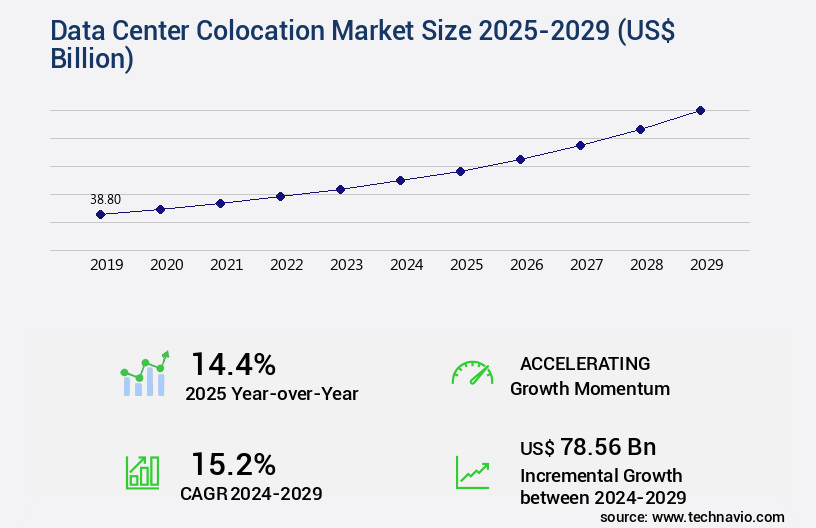
Get Key Insights on Market Forecast (PDF) Request Free Sample
How is the Data Center Colocation Market Segmented and what are the key trends of market segmentation?
The data center colocation industry research report provides comprehensive data (region-wise segment analysis), with forecasts and estimates in "USD billion" for the period 2025-2029, as well as historical data from 2019-2023 for the following segments.
- Type
- Retail colocation
- Wholesale colocation
- End-user
- Small and medium sized enterprises
- Large enterprises
- Geography
- North America
- Europe
- APAC
- South America
- Rest of World (ROW)
By Type Insights
The retail colocation segment is estimated to witness significant growth during the forecast period.
In the dynamic and evolving data center landscape, retail colocation has emerged as a popular choice for businesses seeking cost savings and improved operational efficiency. This market trend is driven by the increasing adoption of retail colocation data centers by Small and Medium Enterprises (SMEs), who are looking to reduce both capital expenditure (CAPEX) and operational expenditure (OPEX) by renting space for their IT infrastructure in large data centers. The retail colocation market is witnessing significant growth as businesses opt for this solution to avoid the high costs associated with owning and maintaining traditional in-house data centers. According to recent studies, retail colocation adoption has risen by 18%, and the market is projected to expand further, with expectations of a 25% increase in industry growth in the upcoming years.
Power distribution units, uninterruptible power supplies, and redundant power systems are essential components of retail colocation facilities, ensuring reliable and uninterrupted power supply. Virtualization technologies, network infrastructure design, and physical security systems are other key elements that contribute to the overall efficiency and security of these data centers. Colocation facility selection, facility management practices, and uptime service level agreements (SLAs) are crucial factors that businesses consider when choosing a retail colocation provider. Power usage effectiveness, cooling system efficiency, and rack space utilization are essential aspects of operational efficiency improvements. Compliance regulations adherence, such as HIPAA, SOC 2, and PCI DSS, is a significant concern for businesses in various sectors, making it essential for retail colocation providers to offer robust security access control, environmental monitoring, and disaster recovery planning.
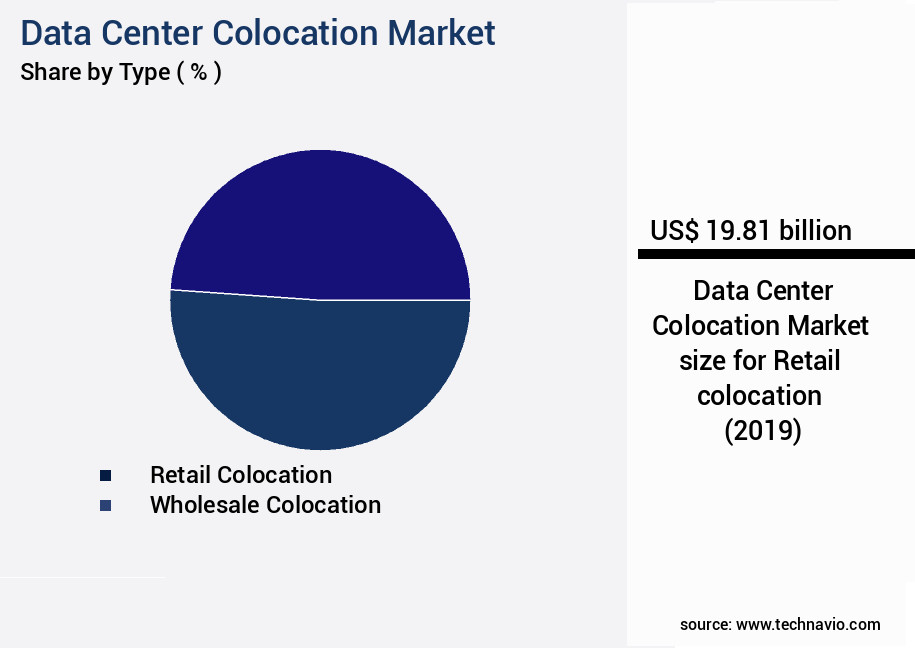
Request Free Sample
The Retail colocation segment was valued at USD 19.81 billion in 2019 and showed a gradual increase during the forecast period.
Cloud connectivity options, remote hands support, and technical support services are additional features that enhance the value proposition of retail colocation services. Energy consumption metrics, server density optimization, and capacity expansion planning are essential considerations for businesses seeking to optimize their IT infrastructure and reduce costs. In conclusion, the retail colocation market is witnessing significant growth due to the evolving needs of businesses for cost savings, improved operational efficiency, and enhanced security and compliance. With the increasing adoption of retail colocation data centers, businesses can focus on their core competencies while leaving the management of their IT infrastructure to the experts.
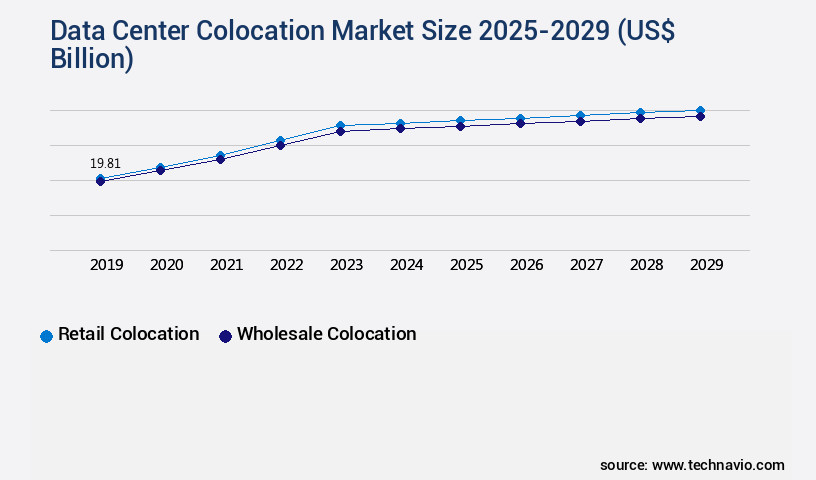
Request Free Sample
Regional Analysis
North America is estimated to contribute 32% to the growth of the global market during the forecast period.Technavio's analysts have elaborately explained the regional trends and drivers that shape the market during the forecast period.
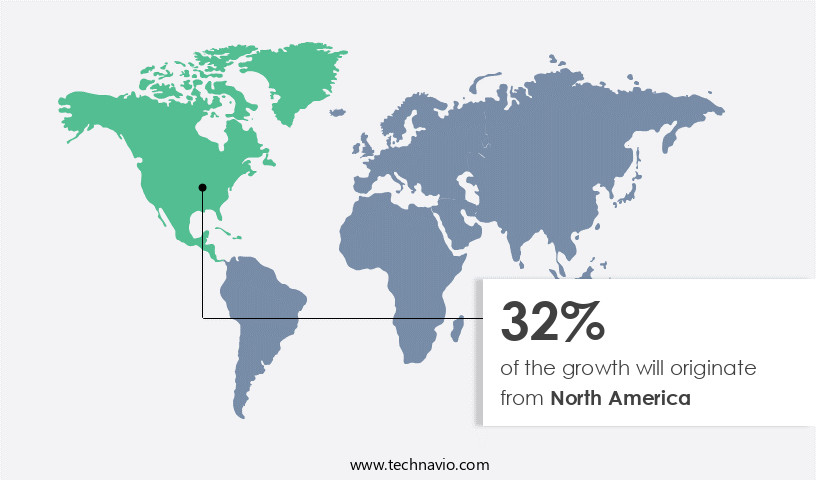
See How Data Center Colocation Market Demand is Rising in North America Request Free Sample
The market in North America is experiencing substantial expansion due to the increasing investments from hyperscale cloud providers, colocation service providers, and enterprises. These entities are upgrading their IT infrastructure to accommodate edge computing, 5G, multi-cloud services, big data analytics, and IoT. The surge in data traffic from businesses and individual consumers is a significant driver of market growth in the region.
Approximately 60% of enterprises in North America plan to increase their use of colocation services in the next 12-24 months. Additionally, the number of IoT devices in use in the region is projected to reach 12.6 billion by 2025. These factors contribute to the exponential growth of the market in North America.
Market Dynamics
Our researchers analyzed the data with 2024 as the base year, along with the key drivers, trends, and challenges. A holistic analysis of drivers will help companies refine their marketing strategies to gain a competitive advantage.
The market is a critical segment of the IT infrastructure landscape, enabling businesses to optimize power usage effectiveness, implement robust physical security, and improve network latency by leveraging colocation facilities. Colocation facilities offer the advantage of assessing cooling system efficiency, enhancing server density, and managing data center capacity expansion. In the quest for proactive disaster recovery strategies, companies are measuring energy consumption in data center operations and optimizing bandwidth capacity planning needs. Colocation facility selection criteria optimization plays a significant role in ensuring compliance with regulations in colocation services. Improving data center uptime SLA metrics is a top priority, necessitating the designing of efficient data center network infrastructure and managing IT equipment lifecycle effectively.
Implementing robust security access control measures is essential, as is outsourcing IT infrastructure to colocation facilities and leveraging virtualization technologies. Moreover, managing cross connect services with colocation providers and monitoring environmental conditions in colocation centers are crucial aspects of maintaining optimal data center performance. The planning of an efficient data center migration process is also a critical consideration. According to market intelligence, adoption rates for advanced cooling technologies in large data centers are nearly double those in small and medium-sized facilities. This underscores the importance of investing in energy-efficient solutions to minimize operational costs and maximize efficiency.
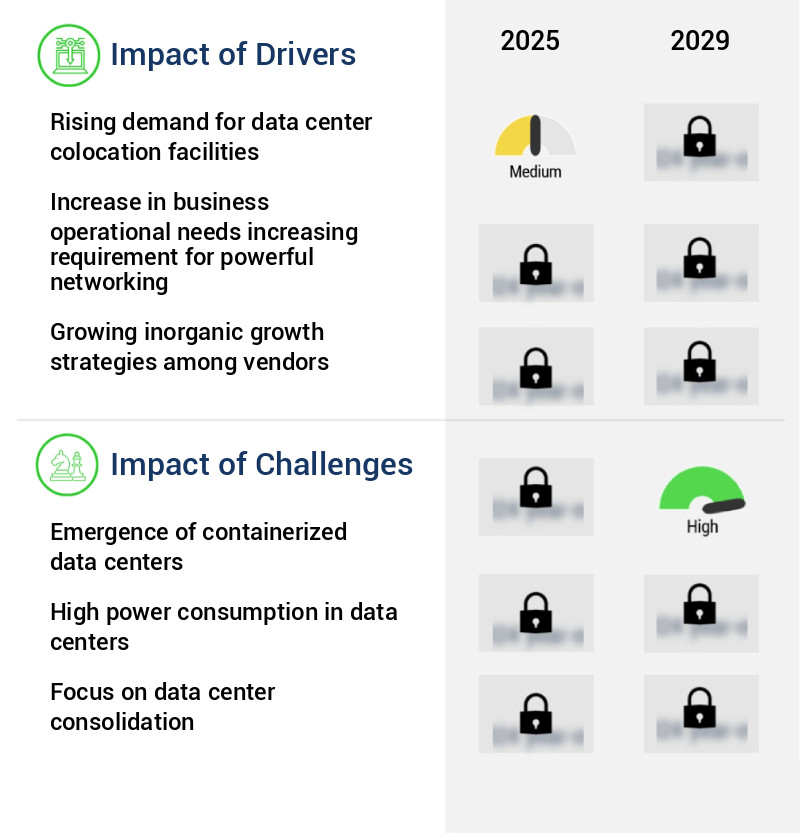
What are the key market drivers leading to the rise in the adoption of Data Center Colocation Industry?
- The increasing demand for colocation facilities in data centers serves as the primary market driver.
- In contrast to building and maintaining an in-house data center, colocation facilities offer enterprises significant advantages. By renting computing servers, storage, and network equipment from colocation providers, businesses can substantially reduce their capital expenditures on infrastructure. Moreover, colocation facilities provide enhanced connectivity essential for operational services, making them an attractive option for businesses seeking to improve their IT infrastructure. Data center colocation refers to the practice of housing an organization's IT equipment in a third-party facility. These facilities offer private racks that enterprises can rent to operate their IT infrastructure. Colocation is particularly beneficial for small and medium-sized enterprises (SMEs) as it enables them to access modern infrastructure at reduced costs.
- The colocation market is experiencing continuous growth, with an increasing number of businesses recognizing the benefits of this model. While some enterprises opt to build and manage their cloud platforms, others prefer the managed services model, which allows them to host their platforms in colocation facilities. The flexibility, cost savings, and improved connectivity offered by colocation facilities make them an indispensable part of the evolving IT landscape.
What are the market trends shaping the Data Center Colocation Industry?
- The trend in the colocation services market is shifting towards innovative cooling approaches. Innovative methods for cooling colocation services are gaining popularity.
- Data centers are essential infrastructure for businesses, but their energy consumption, particularly for cooling, poses significant challenges. Cooling systems account for approximately one-third to one-half of a data center's power usage. To mitigate these costs, service providers are exploring alternatives, such as relocating data centers to cooler regions. For instance, free cooling and liquid immersion cooling techniques are implemented to minimize power consumption. Innovative solutions are also emerging, like the submarine data center. Microsoft, a leading technology company, has introduced a submarine data center several feet beneath the sea off the coast of Orkney, Scotland.
- This underwater facility takes advantage of the cold water temperature to naturally cool the servers, significantly reducing the energy required for cooling. By implementing such advancements, data center service providers aim to enhance facility efficiency and lower operational expenses.
What challenges does the Data Center Colocation Industry face during its growth?
- The emergence of containerized data centers poses a significant challenge to the industry's growth trajectory, necessitating innovative solutions to effectively address the complexities and cost implications associated with this evolving trend.
- In the rapidly evolving data center landscape, containerized data centers have emerged as a flexible and scalable solution. These modular data centers, comprising servers, storage, and networking equipment within shipping containers, can be deployed at various locations. The demand for containerized data centers is escalating due to the need for data center expansion and replacement of conventional facilities. For instance, Schneider Electric SE introduced an Edge container data center in June 2021. Major corporations, such as International Business Machines Corp., are also adopting this technology.
- Containerized data centers offer advantages like ease of deployment, reduced construction time, and energy efficiency. The containerized data center market is witnessing continuous growth, with an increasing number of applications across various sectors, including healthcare, finance, and retail. This shift towards containerized data centers signifies the industry's evolution, offering businesses a more adaptive and cost-effective solution for their data infrastructure needs.
Exclusive Technavio Analysis on Customer Landscape
The data center colocation market forecasting report includes the adoption lifecycle of the market, covering from the innovator's stage to the laggard's stage. It focuses on adoption rates in different regions based on penetration. Furthermore, the data center colocation market report also includes key purchase criteria and drivers of price sensitivity to help companies evaluate and develop their market growth analysis strategies.
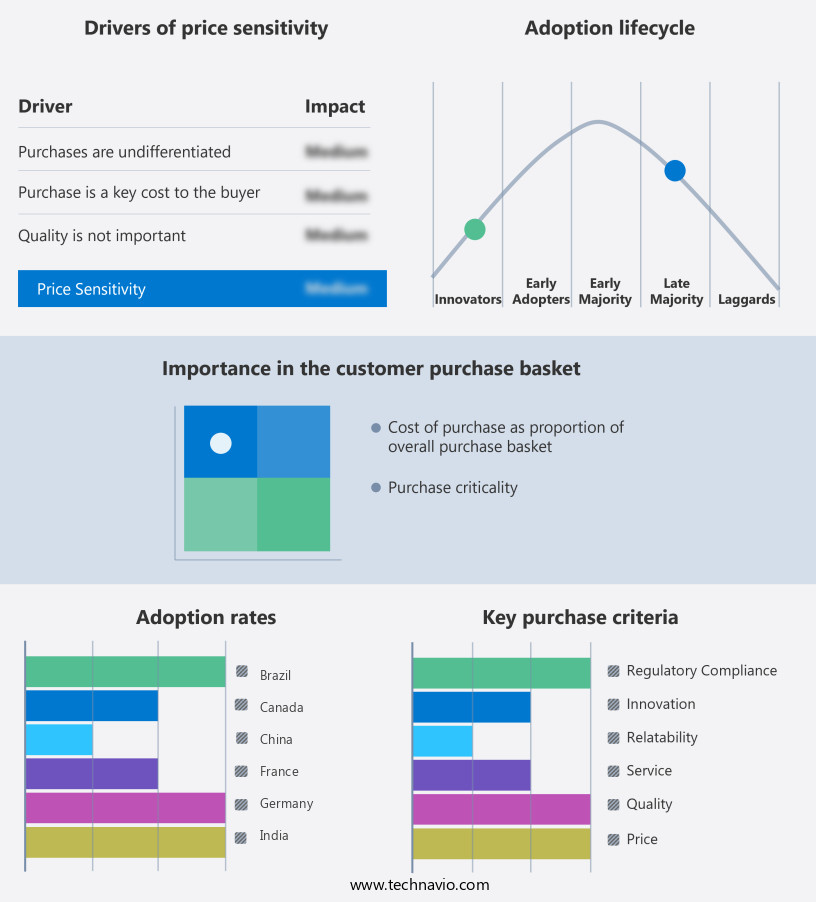
Customer Landscape of Data Center Colocation Industry
Competitive Landscape
Companies are implementing various strategies, such as strategic alliances, data center colocation market forecast, partnerships, mergers and acquisitions, geographical expansion, and product/service launches, to enhance their presence in the industry.
American Tower Corp. - The subsidiary CoreSite Realty Corp. of this company provides businesses with flexible data center solutions, including dedicated connectivity to numerous networks, hybrid cloud capabilities, and IT services.
The industry research and growth report includes detailed analyses of the competitive landscape of the market and information about key companies, including:
- American Tower Corp.
- AT and T Inc.
- BT Group Plc
- China Telecom Corp. Ltd.
- Cologix Inc.
- Colt Technology Services Group Ltd.
- Corporate Technologies LLC
- CtrlS
- Custodian Data Centres
- CyrusOne LLC
- Cyxtera Technologies Inc.
- Digital Realty Trust Inc.
- Equinix Inc.
- Flexential Corp.
- Fujitsu Ltd.
- Internap Holding LLC
- Iron Mountain Inc.
- Lumen Technologies Inc.
- Microsoft Corp.
- NEXTDC LTD.
- Nippon Telegraph and Telephone Corp.
- Retelit
- Switch Inc.
- Telstra Corp. Ltd.
Qualitative and quantitative analysis of companies has been conducted to help clients understand the wider business environment as well as the strengths and weaknesses of key industry players. Data is qualitatively analyzed to categorize companies as pure play, category-focused, industry-focused, and diversified; it is quantitatively analyzed to categorize companies as dominant, leading, strong, tentative, and weak.
Recent Development and News in Data Center Colocation Market
- In January 2024, Equinix, a leading global colocation data center provider, announced the acquisition of Verizon's data center business for approximately USD3.6 billion. This strategic move expanded Equinix's footprint in the North American market and added significant new customers to its roster (Equinix Press Release).
- In March 2024, IBM and Google Cloud formed a partnership to offer joint solutions for hybrid multicloud deployments. The collaboration aimed to help businesses manage their workloads across both IBM's on-premises and Google Cloud data centers, leveraging IBM's expertise in hybrid cloud and Google Cloud's infrastructure (IBM Press Release).
- In May 2024, NTT Communications, a global ICT solutions provider, launched its new hyperscale data center in the US, with an initial capacity of 300 MW. The facility, located in Texas, was designed to cater to the growing demand for colocation services from hyperscale cloud providers and large enterprises (NTT Communications Press Release).
- In January 2025, Digital Realty Trust, a leading global colocation data center provider, raised USD 1.1 billion through a public offering of senior notes. The funds were earmarked for the expansion of its data center portfolio and potential acquisitions (Digital Realty Trust SEC Filing).
Dive into Technavio's robust research methodology, blending expert interviews, extensive data synthesis, and validated models for unparalleled Data Center Colocation Market insights. See full methodology.
|
Market Scope
|
|
Report Coverage
|
Details
|
|
Page number
|
202
|
|
Base year
|
2024
|
|
Historic period
|
2019-2023 |
|
Forecast period
|
2025-2029
|
|
Growth momentum & CAGR
|
Accelerate at a CAGR of 15.2%
|
|
Market growth 2025-2029
|
USD 78.56 billion
|
|
Market structure
|
Fragmented
|
|
YoY growth 2024-2025(%)
|
14.4
|
|
Key countries
|
US, China, Canada, UK, Germany, Japan, Brazil, France, India, and Italy
|
|
Competitive landscape
|
Leading Companies, Market Positioning of Companies, Competitive Strategies, and Industry Risks
|
Request Free Sample
Research Analyst Overview
- In the dynamic and ever-evolving landscape of IT infrastructure outsourcing, the market continues to gain significance. This market is characterized by the adoption of advanced technologies and systems to ensure uninterrupted power supply through power distribution units and uninterruptible power supply systems. The integration of virtualization technologies and redundant power systems further enhances operational efficiency and reliability. Physical security systems, HVAC system design, and compliance regulations adherence are essential components of modern colocation facilities. Power usage effectiveness, network infrastructure design, and capacity expansion planning are critical factors influencing colocation facility selection. Facility management practices, uptime SLAs, and bandwidth capacity planning are essential elements of successful colocation operations.
- Thermal management strategies, such as cooling system efficiency and rack space utilization, are crucial in maintaining optimal environmental conditions. Environmental monitoring, security access control, and capacity expansion planning are integral to maintaining a robust and reliable colocation environment. Energy consumption metrics, cloud connectivity options, disaster recovery planning, and remote hands support are additional services that enhance the value proposition of colocation providers. Fiber optic cabling, cross connect services, and technical support services are essential components of a comprehensive colocation offering. Service level agreements, data center migration, network latency measurement, hardware maintenance contracts, server density optimization, and operational efficiency improvements are key areas of focus for colocation providers seeking to differentiate themselves in the market.
- In conclusion, the market is a continuously evolving landscape, driven by the adoption of advanced technologies and systems to ensure uninterrupted power supply, optimal environmental conditions, and robust security. Colocation providers must focus on delivering value-added services and operational efficiency improvements to meet the evolving needs of their clients.
What are the Key Data Covered in this Data Center Colocation Market Research and Growth Report?
-
What is the expected growth of the Data Center Colocation Market between 2025 and 2029?
-
What segmentation does the market report cover?
-
The report segmented by Type (Retail colocation and Wholesale colocation), End-user (Small and medium sized enterprises and Large enterprises), and Geography (North America, APAC, Europe, South America, and Middle East and Africa)
-
Which regions are analyzed in the report?
-
North America, APAC, Europe, South America, and Middle East and Africa
-
What are the key growth drivers and market challenges?
-
Who are the major players in the Data Center Colocation Market?
-
Key Companies American Tower Corp., AT and T Inc., BT Group Plc, China Telecom Corp. Ltd., Cologix Inc., Colt Technology Services Group Ltd., Corporate Technologies LLC, CtrlS, Custodian Data Centres, CyrusOne LLC, Cyxtera Technologies Inc., Digital Realty Trust Inc., Equinix Inc., Flexential Corp., Fujitsu Ltd., Internap Holding LLC, Iron Mountain Inc., Lumen Technologies Inc., Microsoft Corp., NEXTDC LTD., Nippon Telegraph and Telephone Corp., Retelit, Switch Inc., and Telstra Corp. Ltd.
Market Research Insights
- The market encompasses the provision of physical space and infrastructure for businesses to house their IT equipment, alongside essential services such as power distribution, access control systems, and environmental control. According to industry estimates, the global colocation market is projected to reach USD 75 billion by 2025, representing a significant compound annual growth rate. This expansion is driven by the increasing demand for operational efficiency, compliance requirements, and network connectivity. Power efficiency metrics have become a crucial factor in data center decision-making, with energy consumption reduction a top priority for many organizations. For instance, a leading colocation provider reports an average power usage effectiveness (PUE) rating of 1.2, significantly lower than the industry average of 1.9.
- This improvement not only reduces environmental impact but also translates to substantial cost savings for clients. By offering advanced cooling systems, backup power systems, and IT infrastructure management, colocation providers enable businesses to focus on their core competencies while ensuring optimal performance and risk mitigation.
We can help! Our analysts can customize this data center colocation market research report to meet your requirements.
Get in touch
1 Executive Summary
- 1.1 Market overview
- Executive Summary - Chart on Market Overview
- Executive Summary - Data Table on Market Overview
- Executive Summary - Chart on Global Market Characteristics
- Executive Summary - Chart on Market by Geography
- Executive Summary - Chart on Market Segmentation by Type
- Executive Summary - Chart on Market Segmentation by End-user
- Executive Summary - Chart on Incremental Growth
- Executive Summary - Data Table on Incremental Growth
- Executive Summary - Chart on Company Market Positioning
2 Technavio Analysis
- 2.1 Analysis of price sensitivity, lifecycle, customer purchase basket, adoption rates, and purchase criteria
- Analysis of price sensitivity, lifecycle, customer purchase basket, adoption rates, and purchase criteria
- 2.2 Criticality of inputs and Factors of differentiation
- Overview on criticality of inputs and factors of differentiation
- 2.3 Factors of disruption
- Overview on factors of disruption
- 2.4 Impact of drivers and challenges
- Impact of drivers and challenges in 2024 and 2029
3 Market Landscape
- 3.1 Market ecosystem
- Parent Market
- Data Table on - Parent Market
- 3.2 Market characteristics
- Market characteristics analysis
4 Market Sizing
- 4.1 Market definition
- Offerings of companies included in the market definition
- 4.2 Market segment analysis
- 4.4 Market outlook: Forecast for 2024-2029
- Chart on Global - Market size and forecast 2024-2029 ($ million)
- Data Table on Global - Market size and forecast 2024-2029 ($ million)
- Chart on Global Market: Year-over-year growth 2024-2029 (%)
- Data Table on Global Market: Year-over-year growth 2024-2029 (%)
5 Historic Market Size
- 5.1 Global Data Center Colocation Market 2019 - 2023
- Historic Market Size - Data Table on Global Data Center Colocation Market 2019 - 2023 ($ million)
- 5.2 Type segment analysis 2019 - 2023
- Historic Market Size - Type Segment 2019 - 2023 ($ million)
- 5.3 End-user segment analysis 2019 - 2023
- Historic Market Size - End-user Segment 2019 - 2023 ($ million)
- 5.4 Geography segment analysis 2019 - 2023
- Historic Market Size - Geography Segment 2019 - 2023 ($ million)
- 5.5 Country segment analysis 2019 - 2023
- Historic Market Size - Country Segment 2019 - 2023 ($ million)
6 Qualitative Analysis
- 6.1 Impact of AI on the Global Data Center Colocation Market 2025-2029
7 Five Forces Analysis
- 7.1 Five forces summary
- Five forces analysis - Comparison between 2024 and 2029
- 7.2 Bargaining power of buyers
- Bargaining power of buyers - Impact of key factors 2024 and 2029
- 7.3 Bargaining power of suppliers
- Bargaining power of suppliers - Impact of key factors in 2024 and 2029
- 7.4 Threat of new entrants
- Threat of new entrants - Impact of key factors in 2024 and 2029
- 7.5 Threat of substitutes
- Threat of substitutes - Impact of key factors in 2024 and 2029
- 7.6 Threat of rivalry
- Threat of rivalry - Impact of key factors in 2024 and 2029
- 7.7 Market condition
- Chart on Market condition - Five forces 2024 and 2029
8 Market Segmentation by Type
- 8.1 Market segments
- Chart on Type - Market share 2024-2029 (%)
- Data Table on Type - Market share 2024-2029 (%)
- 8.2 Comparison by Type
- Chart on Comparison by Type
- Data Table on Comparison by Type
- 8.3 Retail colocation - Market size and forecast 2024-2029
- Chart on Retail colocation - Market size and forecast 2024-2029 ($ million)
- Data Table on Retail colocation - Market size and forecast 2024-2029 ($ million)
- Chart on Retail colocation - Year-over-year growth 2024-2029 (%)
- Data Table on Retail colocation - Year-over-year growth 2024-2029 (%)
- 8.4 Wholesale colocation - Market size and forecast 2024-2029
- Chart on Wholesale colocation - Market size and forecast 2024-2029 ($ million)
- Data Table on Wholesale colocation - Market size and forecast 2024-2029 ($ million)
- Chart on Wholesale colocation - Year-over-year growth 2024-2029 (%)
- Data Table on Wholesale colocation - Year-over-year growth 2024-2029 (%)
- 8.5 Market opportunity by Type
- Market opportunity by Type ($ million)
- Data Table on Market opportunity by Type ($ million)
9 Market Segmentation by End-user
- 9.1 Market segments
- Chart on End-user - Market share 2024-2029 (%)
- Data Table on End-user - Market share 2024-2029 (%)
- 9.2 Comparison by End-user
- Chart on Comparison by End-user
- Data Table on Comparison by End-user
- 9.3 Small and medium sized enterprises - Market size and forecast 2024-2029
- Chart on Small and medium sized enterprises - Market size and forecast 2024-2029 ($ million)
- Data Table on Small and medium sized enterprises - Market size and forecast 2024-2029 ($ million)
- Chart on Small and medium sized enterprises - Year-over-year growth 2024-2029 (%)
- Data Table on Small and medium sized enterprises - Year-over-year growth 2024-2029 (%)
- 9.4 Large enterprises - Market size and forecast 2024-2029
- Chart on Large enterprises - Market size and forecast 2024-2029 ($ million)
- Data Table on Large enterprises - Market size and forecast 2024-2029 ($ million)
- Chart on Large enterprises - Year-over-year growth 2024-2029 (%)
- Data Table on Large enterprises - Year-over-year growth 2024-2029 (%)
- 9.5 Market opportunity by End-user
- Market opportunity by End-user ($ million)
- Data Table on Market opportunity by End-user ($ million)
10 Customer Landscape
- 10.1 Customer landscape overview
- Analysis of price sensitivity, lifecycle, customer purchase basket, adoption rates, and purchase criteria
11 Geographic Landscape
- 11.1 Geographic segmentation
- Chart on Market share by geography 2024-2029 (%)
- Data Table on Market share by geography 2024-2029 (%)
- 11.2 Geographic comparison
- Chart on Geographic comparison
- Data Table on Geographic comparison
- 11.3 North America - Market size and forecast 2024-2029
- Chart on North America - Market size and forecast 2024-2029 ($ million)
- Data Table on North America - Market size and forecast 2024-2029 ($ million)
- Chart on North America - Year-over-year growth 2024-2029 (%)
- Data Table on North America - Year-over-year growth 2024-2029 (%)
- 11.4 APAC - Market size and forecast 2024-2029
- Chart on APAC - Market size and forecast 2024-2029 ($ million)
- Data Table on APAC - Market size and forecast 2024-2029 ($ million)
- Chart on APAC - Year-over-year growth 2024-2029 (%)
- Data Table on APAC - Year-over-year growth 2024-2029 (%)
- 11.5 Europe - Market size and forecast 2024-2029
- Chart on Europe - Market size and forecast 2024-2029 ($ million)
- Data Table on Europe - Market size and forecast 2024-2029 ($ million)
- Chart on Europe - Year-over-year growth 2024-2029 (%)
- Data Table on Europe - Year-over-year growth 2024-2029 (%)
- 11.6 South America - Market size and forecast 2024-2029
- Chart on South America - Market size and forecast 2024-2029 ($ million)
- Data Table on South America - Market size and forecast 2024-2029 ($ million)
- Chart on South America - Year-over-year growth 2024-2029 (%)
- Data Table on South America - Year-over-year growth 2024-2029 (%)
- 11.7 Middle East and Africa - Market size and forecast 2024-2029
- Chart on Middle East and Africa - Market size and forecast 2024-2029 ($ million)
- Data Table on Middle East and Africa - Market size and forecast 2024-2029 ($ million)
- Chart on Middle East and Africa - Year-over-year growth 2024-2029 (%)
- Data Table on Middle East and Africa - Year-over-year growth 2024-2029 (%)
- 11.8 US - Market size and forecast 2024-2029
- Chart on US - Market size and forecast 2024-2029 ($ million)
- Data Table on US - Market size and forecast 2024-2029 ($ million)
- Chart on US - Year-over-year growth 2024-2029 (%)
- Data Table on US - Year-over-year growth 2024-2029 (%)
- 11.9 China - Market size and forecast 2024-2029
- Chart on China - Market size and forecast 2024-2029 ($ million)
- Data Table on China - Market size and forecast 2024-2029 ($ million)
- Chart on China - Year-over-year growth 2024-2029 (%)
- Data Table on China - Year-over-year growth 2024-2029 (%)
- 11.10 Canada - Market size and forecast 2024-2029
- Chart on Canada - Market size and forecast 2024-2029 ($ million)
- Data Table on Canada - Market size and forecast 2024-2029 ($ million)
- Chart on Canada - Year-over-year growth 2024-2029 (%)
- Data Table on Canada - Year-over-year growth 2024-2029 (%)
- 11.11 UK - Market size and forecast 2024-2029
- Chart on UK - Market size and forecast 2024-2029 ($ million)
- Data Table on UK - Market size and forecast 2024-2029 ($ million)
- Chart on UK - Year-over-year growth 2024-2029 (%)
- Data Table on UK - Year-over-year growth 2024-2029 (%)
- 11.12 Germany - Market size and forecast 2024-2029
- Chart on Germany - Market size and forecast 2024-2029 ($ million)
- Data Table on Germany - Market size and forecast 2024-2029 ($ million)
- Chart on Germany - Year-over-year growth 2024-2029 (%)
- Data Table on Germany - Year-over-year growth 2024-2029 (%)
- 11.13 Japan - Market size and forecast 2024-2029
- Chart on Japan - Market size and forecast 2024-2029 ($ million)
- Data Table on Japan - Market size and forecast 2024-2029 ($ million)
- Chart on Japan - Year-over-year growth 2024-2029 (%)
- Data Table on Japan - Year-over-year growth 2024-2029 (%)
- 11.14 Brazil - Market size and forecast 2024-2029
- Chart on Brazil - Market size and forecast 2024-2029 ($ million)
- Data Table on Brazil - Market size and forecast 2024-2029 ($ million)
- Chart on Brazil - Year-over-year growth 2024-2029 (%)
- Data Table on Brazil - Year-over-year growth 2024-2029 (%)
- 11.15 India - Market size and forecast 2024-2029
- Chart on India - Market size and forecast 2024-2029 ($ million)
- Data Table on India - Market size and forecast 2024-2029 ($ million)
- Chart on India - Year-over-year growth 2024-2029 (%)
- Data Table on India - Year-over-year growth 2024-2029 (%)
- 11.16 France - Market size and forecast 2024-2029
- Chart on France - Market size and forecast 2024-2029 ($ million)
- Data Table on France - Market size and forecast 2024-2029 ($ million)
- Chart on France - Year-over-year growth 2024-2029 (%)
- Data Table on France - Year-over-year growth 2024-2029 (%)
- 11.17 Italy - Market size and forecast 2024-2029
- Chart on Italy - Market size and forecast 2024-2029 ($ million)
- Data Table on Italy - Market size and forecast 2024-2029 ($ million)
- Chart on Italy - Year-over-year growth 2024-2029 (%)
- Data Table on Italy - Year-over-year growth 2024-2029 (%)
- 11.18 Market opportunity by geography
- Market opportunity by geography ($ million)
- Data Tables on Market opportunity by geography ($ million)
12 Drivers, Challenges, and Opportunity/Restraints
- 12.3 Impact of drivers and challenges
- Impact of drivers and challenges in 2024 and 2029
- 12.4 Market opportunities/restraints
13 Competitive Landscape
- 13.2 Competitive Landscape
- Overview on criticality of inputs and factors of differentiation
- 13.3 Landscape disruption
- Overview on factors of disruption
- 13.4 Industry risks
- Impact of key risks on business
14 Competitive Analysis
- 14.2 Company ranking index
- 14.3 Market positioning of companies
- Matrix on companies position and classification
- 14.4 American Tower Corp.
- American Tower Corp. - Overview
- American Tower Corp. - Business segments
- American Tower Corp. - Key offerings
- American Tower Corp. - Segment focus
- SWOT
- 14.5 AT and T Inc.
- AT and T Inc. - Overview
- AT and T Inc. - Business segments
- AT and T Inc. - Key news
- AT and T Inc. - Key offerings
- AT and T Inc. - Segment focus
- SWOT
- 14.6 BT Group Plc
- BT Group Plc - Overview
- BT Group Plc - Business segments
- BT Group Plc - Key offerings
- BT Group Plc - Segment focus
- SWOT
- 14.7 China Telecom Corp. Ltd.
- China Telecom Corp. Ltd. - Overview
- China Telecom Corp. Ltd. - Product / Service
- China Telecom Corp. Ltd. - Key offerings
- SWOT
- 14.8 Cologix Inc.
- Cologix Inc. - Overview
- Cologix Inc. - Product / Service
- Cologix Inc. - Key offerings
- SWOT
- 14.9 Colt Technology Services Group Ltd.
- Colt Technology Services Group Ltd. - Overview
- Colt Technology Services Group Ltd. - Product / Service
- Colt Technology Services Group Ltd. - Key offerings
- SWOT
- 14.10 CyrusOne LLC
- CyrusOne LLC - Overview
- CyrusOne LLC - Product / Service
- CyrusOne LLC - Key offerings
- SWOT
- 14.11 Digital Realty Trust Inc.
- Digital Realty Trust Inc. - Overview
- Digital Realty Trust Inc. - Product / Service
- Digital Realty Trust Inc. - Key news
- Digital Realty Trust Inc. - Key offerings
- SWOT
- 14.12 Equinix Inc.
- Equinix Inc. - Overview
- Equinix Inc. - Business segments
- Equinix Inc. - Key news
- Equinix Inc. - Key offerings
- Equinix Inc. - Segment focus
- SWOT
- 14.13 Fujitsu Ltd.
- Fujitsu Ltd. - Overview
- Fujitsu Ltd. - Business segments
- Fujitsu Ltd. - Key news
- Fujitsu Ltd. - Key offerings
- Fujitsu Ltd. - Segment focus
- SWOT
- 14.14 Iron Mountain Inc.
- Iron Mountain Inc. - Overview
- Iron Mountain Inc. - Business segments
- Iron Mountain Inc. - Key news
- Iron Mountain Inc. - Key offerings
- Iron Mountain Inc. - Segment focus
- SWOT
- 14.15 NEXTDC LTD.
- NEXTDC LTD. - Overview
- NEXTDC LTD. - Product / Service
- NEXTDC LTD. - Key offerings
- SWOT
- 14.16 Retelit
- Retelit - Overview
- Retelit - Product / Service
- Retelit - Key offerings
- SWOT
- 14.17 Switch Inc.
- Switch Inc. - Overview
- Switch Inc. - Product / Service
- Switch Inc. - Key offerings
- SWOT
- 14.18 Telstra Corp. Ltd.
- Telstra Corp. Ltd. - Overview
- Telstra Corp. Ltd. - Business segments
- Telstra Corp. Ltd. - Key offerings
- Telstra Corp. Ltd. - Segment focus
- SWOT
15 Appendix
- 15.2 Inclusions and exclusions checklist
- Inclusions checklist
- Exclusions checklist
- 15.3 Currency conversion rates for US$
- Currency conversion rates for US$
- 15.4 Research methodology
- 15.7 Validation techniques employed for market sizing
- Validation techniques employed for market sizing
- 15.9 360 degree market analysis
- 360 degree market analysis
- 15.10 List of abbreviations







![]() Get the report (PDF) sent to your email within minutes.
Get the report (PDF) sent to your email within minutes.
Complimentary full Excel data with your report purchase.